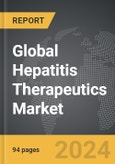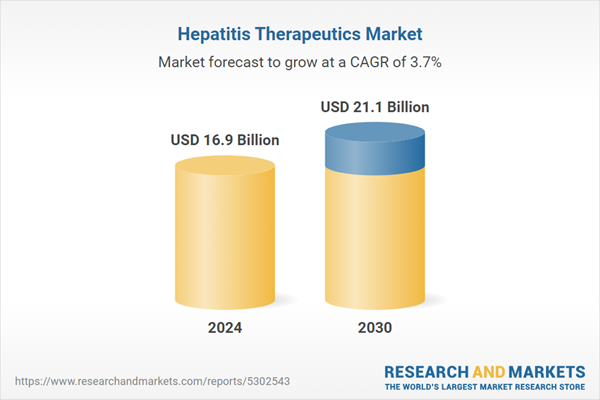Global Hepatitis Therapeutics Market - Key Trends and Drivers Summarized
How Are Hepatitis Therapeutics Advancing the Fight Against Chronic Hepatitis?
Hepatitis therapeutics have evolved significantly in recent years, providing patients with more effective treatment options for managing chronic hepatitis infections, particularly hepatitis B and C. Chronic hepatitis can lead to severe liver complications, including cirrhosis, liver failure, and liver cancer if left untreated. Therapeutic options for hepatitis include antiviral medications, immune modulators, and interferon therapies designed to reduce viral replication and prevent liver damage. The advent of direct-acting antivirals (DAAs) has revolutionized the treatment of hepatitis C, offering high cure rates and shorter treatment durations compared to previous therapies. With the ongoing development of new therapeutic agents, the hepatitis therapeutics market continues to expand, addressing the unmet needs of patients worldwide.How Are Technological Innovations Influencing the Hepatitis Therapeutics Market?
Technological advancements in drug development and personalized medicine have significantly impacted the hepatitis therapeutics market. Direct-acting antivirals (DAAs) have transformed the treatment landscape for hepatitis C, achieving cure rates exceeding 95% in many cases. These therapies target specific proteins essential for viral replication, leading to more targeted and effective treatments with fewer side effects. Additionally, advancements in biologics and gene therapies are being explored for hepatitis B, offering new hope for achieving a functional cure, which has long eluded researchers. Improved diagnostic tools also enable personalized treatment regimens, allowing clinicians to tailor therapies based on viral genotypes, patient history, and potential drug resistance.How Do Market Segments Influence the Hepatitis Therapeutics Industry?
Drug classes include antivirals, immune modulators, and combination therapies, with direct-acting antivirals (DAAs) leading the market due to their effectiveness in curing hepatitis C. Therapeutic types are also segmented based on the specific virus being treated - hepatitis B, C, or other variants - where hepatitis C therapies dominate, given the recent breakthroughs in antiviral treatments. Distribution channels include hospital pharmacies, retail pharmacies, and online platforms, with hospital pharmacies accounting for the largest market share due to the need for specialized treatment administration and monitoring.What Factors Are Driving the Growth in the Hepatitis Therapeutics Market?
The growth in the hepatitis therapeutics market is driven by several factors, including the increasing prevalence of chronic hepatitis infections, the development of highly effective direct-acting antivirals (DAAs), and advancements in personalized medicine. The global burden of hepatitis, particularly hepatitis B and C, continues to drive demand for effective treatments, with millions of individuals requiring long-term management of their condition. The approval of new hepatitis C therapies, which offer shorter treatment durations and fewer side effects, has led to increased treatment rates and market growth. In addition, the development of novel therapeutic approaches, such as gene therapy and biologics, is expected to open new avenues for treating hepatitis B. The expansion of healthcare infrastructure in emerging markets and government initiatives aimed at eradicating hepatitis further support the growth of this market.Report Scope
The report analyzes the Hepatitis Therapeutics market, presented in terms of market value (US$ Thousand). The analysis covers the key segments and geographic regions outlined below.- Segments: Disease Type (Hepatitis C, Hepatitis B, Hepatitis A, Other Disease Types); Drug Class (Nucleotide Polymerase / NS5A Inhibitor Combinations, HIV NRTIs, NS5A Inhibitors, Nucleotide Polymerase Inhibitors, Interferon Alphas, Nucleoside Analogue Antivirals, Thrombopoiesis Stimulating Agents, Hepatitis C Protease / NS5A Inhibitor Combinations).
- Geographic Regions/Countries:World; United States; Canada; Japan; China; Europe (France; Germany; Italy; United Kingdom; Spain; Russia; and Rest of Europe); Asia-Pacific (Australia; India; South Korea; and Rest of Asia-Pacific); Latin America (Argentina; Brazil; Mexico; and Rest of Latin America); Middle East (Iran; Israel; Saudi Arabia; United Arab Emirates; and Rest of Middle East); and Africa.
Key Insights:
- Market Growth: Understand the significant growth trajectory of the Hepatitis C Therapeutics segment, which is expected to reach US$17.8 Billion by 2030 with a CAGR of a 4%. The Hepatitis B Therapeutics segment is also set to grow at 2.8% CAGR over the analysis period.
- Regional Analysis: Gain insights into the U.S. market, valued at $4.5 Billion in 2024, and China, forecasted to grow at an impressive 5.9% CAGR to reach $4.4 Billion by 2030. Discover growth trends in other key regions, including Japan, Canada, Germany, and the Asia-Pacific.
Why You Should Buy This Report:
- Detailed Market Analysis: Access a thorough analysis of the Global Hepatitis Therapeutics Market, covering all major geographic regions and market segments.
- Competitive Insights: Get an overview of the competitive landscape, including the market presence of major players across different geographies.
- Future Trends and Drivers: Understand the key trends and drivers shaping the future of the Global Hepatitis Therapeutics Market.
- Actionable Insights: Benefit from actionable insights that can help you identify new revenue opportunities and make strategic business decisions.
Key Questions Answered:
- How is the Global Hepatitis Therapeutics Market expected to evolve by 2030?
- What are the main drivers and restraints affecting the market?
- Which market segments will grow the most over the forecast period?
- How will market shares for different regions and segments change by 2030?
- Who are the leading players in the market, and what are their prospects?
Report Features:
- Comprehensive Market Data: Independent analysis of annual sales and market forecasts in US$ Million from 2024 to 2030.
- In-Depth Regional Analysis: Detailed insights into key markets, including the U.S., China, Japan, Canada, Europe, Asia-Pacific, Latin America, Middle East, and Africa.
- Company Profiles: Coverage of players such as AbbVie, Inc., Abivax SA, Bristol-Myers Squibb Company, Cipla, Inc., Gilead and more.
- Complimentary Updates: Receive free report updates for one year to keep you informed of the latest market developments.
Some of the 43 companies featured in this Hepatitis Therapeutics market report include:
- AbbVie, Inc.
- Abivax SA
- Bristol-Myers Squibb Company
- Cipla, Inc.
- Gilead
- GlaxoSmithKline plc
- Hetero Healthcare Ltd.
- Hoffmann-La Roche, Ltd.
- Johnson & Johnson
- Laurus Ltd.
- Merck & Co., Inc.
- Natco Pharma Ltd.
- Novartis AG
- Novira Therapeutics
- Zydus Cadila
This edition integrates the latest global trade and economic shifts into comprehensive market analysis. Key updates include:
- Tariff and Trade Impact: Insights into global tariff negotiations across 180+ countries, with analysis of supply chain turbulence, sourcing disruptions, and geographic realignment. Special focus on 2025 as a pivotal year for trade tensions, including updated perspectives on the Trump-era tariffs.
- Adjusted Forecasts and Analytics: Revised global and regional market forecasts through 2030, incorporating tariff effects, economic uncertainty, and structural changes in globalization. Includes historical analysis from 2015 to 2023.
- Strategic Market Dynamics: Evaluation of revised market prospects, regional outlooks, and key economic indicators such as population and urbanization trends.
- Innovation & Technology Trends: Latest developments in product and process innovation, emerging technologies, and key industry drivers shaping the competitive landscape.
- Competitive Intelligence: Updated global market share estimates for 2025, competitive positioning of major players (Strong/Active/Niche/Trivial), and refined focus on leading global brands and core players.
- Expert Insight & Commentary: Strategic analysis from economists, trade experts, and domain specialists to contextualize market shifts and identify emerging opportunities.
Table of Contents
Companies Mentioned (Partial List)
A selection of companies mentioned in this report includes, but is not limited to:
- AbbVie, Inc.
- Abivax SA
- Bristol-Myers Squibb Company
- Cipla, Inc.
- Gilead
- GlaxoSmithKline plc
- Hetero Healthcare Ltd.
- Hoffmann-La Roche, Ltd.
- Johnson & Johnson
- Laurus Ltd.
- Merck & Co., Inc.
- Natco Pharma Ltd.
- Novartis AG
- Novira Therapeutics
- Zydus Cadila
Table Information
| Report Attribute | Details |
|---|---|
| No. of Pages | 298 |
| Published | December 2025 |
| Forecast Period | 2024 - 2030 |
| Estimated Market Value ( USD | $ 16.9 Billion |
| Forecasted Market Value ( USD | $ 21.1 Billion |
| Compound Annual Growth Rate | 3.7% |
| Regions Covered | Global |









